Florida is one of the states with the most venomous snakes. Many specific species found in the Southeast are located in Florida.
Snakes are common all around the state. Most species are found in peninsular Florida where they can find plenty of food such as rodents, birds, eggs, and insects.
Table of Contents
Are There Venomous Snakes in Florida?
Florida is one of the states with a high number of venomous snakes. Both terrestrial and aquatic species can be venomous here.
The Florida Cottonmouth and the Dusky Pygmy Rattlesnake are just a few of the venomous snakes in the state.
Florida is also home to invasive species of pythons which are some of the largest snakes in the world.
52 Types of Snakes in Florida
The following snakes are either venomous or not. Some of them are native to Florida.
1. North American Racer

Scientific name: Coluber Constrictor
Common name: North American racer, Eastern racer
Venomous: No
The North American Racer is the most common snake species in Florida.
It’s most common in the Florida Keys but its habitat is widespread in all regions of the state.
North American Racers have an all-black color as adults. They can be seen in woodlands, prairies, sandhills, and all other dry areas of Florida.
This snake isn’t venomous and it’s fairly docile. It bites repeatedly when molested, however.
North American Racers eat small birds, mammals, and lizards. They can also eat small snakes.
2. Banded Watersnake
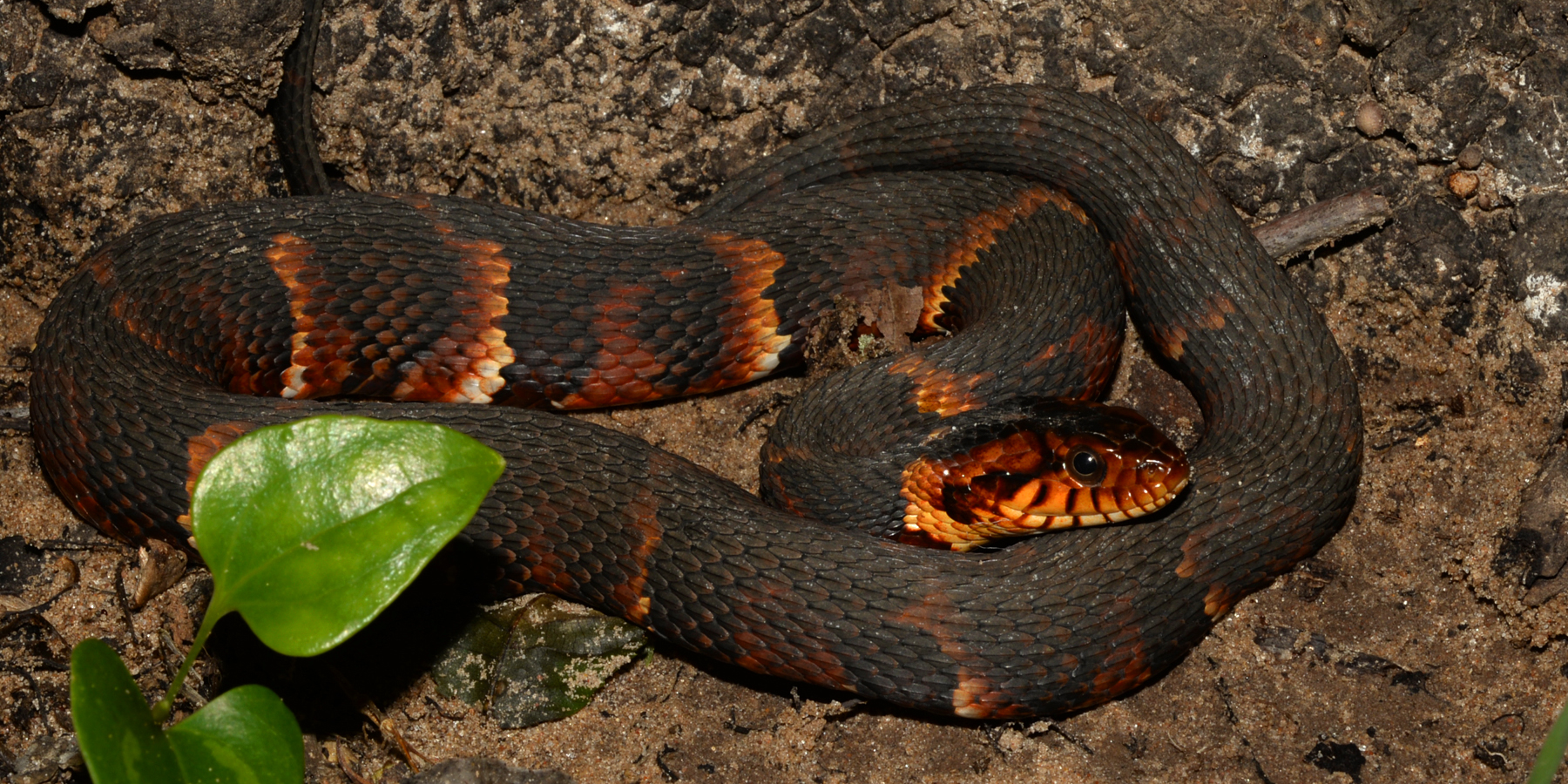
Scientific name: Nerodia fasciata
Common name: Banded watersnake, Southern watersnake
Venomous: No
The Banded Watersnake is found all across Eastern Florida.
Snakes of this species live in freshwater habitats such as streams and marshes where they feed on fish and small frogs.
This common species is also seen frequently around the state as its both diurnal and nocturnal.
It can be identified by a gray, green-gray, or brown color and a size of up to 41 inches.
Their aquatic habitat often makes people confuse the Banded Watersnake with dangerous venomous aquatic specie such as Cottonmouths.
3. Florida Cottonmouth

Scientific name: Agkistrodon conanti
Common name: Florida cottonmouth
Venomous: Yes
Florida Cottonmouths are some of the most venomous snakes in the state. Its venom is associated with a high mortality rate.
The species can be separated from other water snakes through its cat-like vertical pupils.
Snakes of this species grow to 48 inches.
These snakes are known to darken with age. Some of the oldest Florida Cottonmouth snakes are known for having a dull almost uniform color.
4. Corn Snake
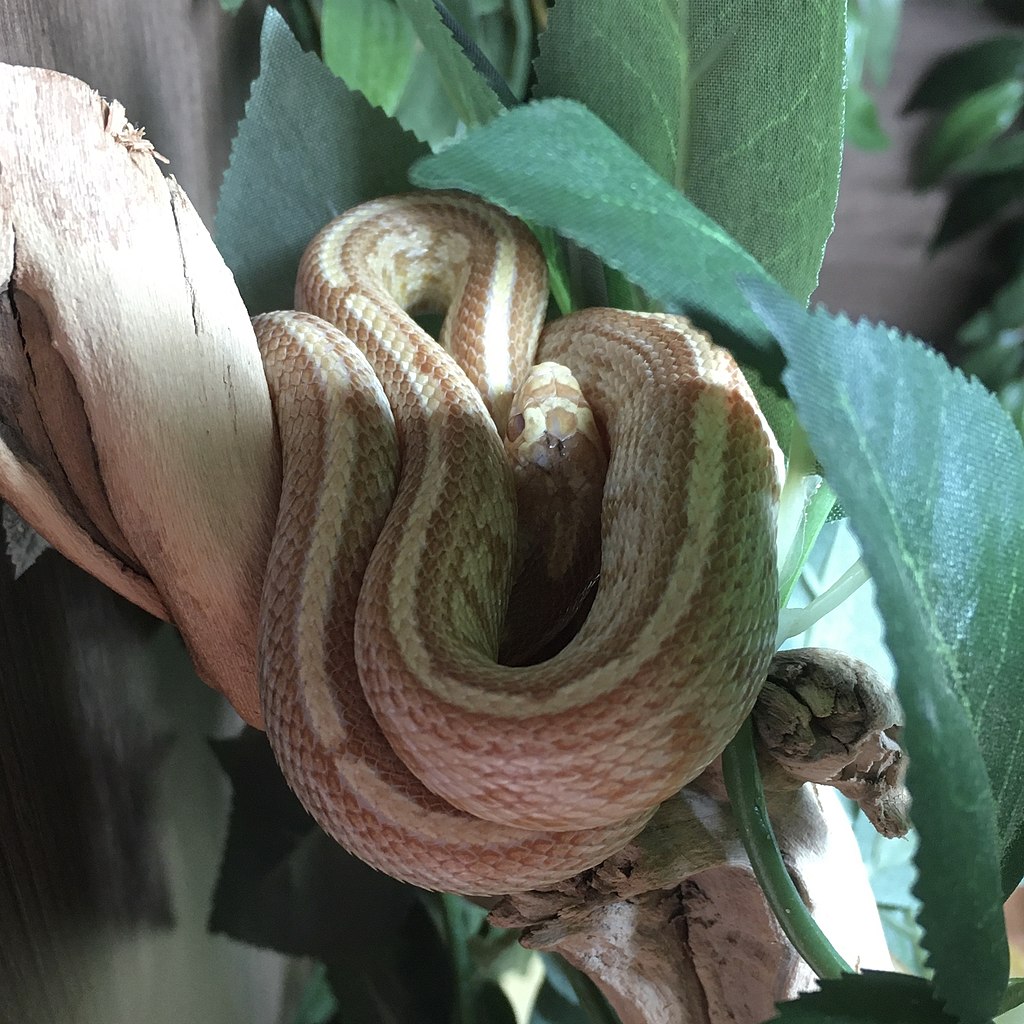
Scientific name: Pantherophis guttatus
Common name: Corn snake
Venomous: No
Corn snakes are a species of nonvenomous snakes found in the US.
These snakes are mostly nocturnal although they can feed early in the morning as well.
It’s believed these snakes eat during the day when they go hungry, as they only eat every few days.
Corn snakes use constriction to catch small prey such as lizards and small mammals.
They can often be seen in the burrows of rodents where they sleep and eat mice and rats.
These snakes are beneficial as they eat rats which can spread diseases and pests such as lice.
5. Eastern Ratsnake

Scientific name: Pantherophis alleghaniensis
Common name: Eastern ratsnake, Black rat snake, Pilot snake, Pilot black snake, Chicken snake, Yellow rats nake, Everglades rat snake
Venomous: No
Eastern Ratsnakes are known as Yellow Rat snakes in Florida. They are an agile non-venomous species.
As a climber, these snakes easily make their way into homes and attics by climbing trees.
Snakes of this family are known to eat rodents but they also eat chicken and lizards.
The species represents a terrestrial burrower snake, even if it can climb walls and trees.
Eastern Ratsnakes are known to overwinter in burrows or homes. They seek out maximum sun exposure whenever temperatures drop.
6. Dusky Pygmy Rattlesnake

Scientific name: Sistrurus miliarius barbouri
Common name: Dusky pygmy rattlesnake, Barbour’s pygmy rattlesnake, Florida ground rattlesnake, Ground rattlesnake, Hog-nosed rattler, Pygmy ground rattlesnake, Pygmy rattler, Pygmy rattlesnake, Small rattlesnake, Southeastern ground rattlesnake
Venomous: Yes
The Dusky Pygmy Rattlesnake is one of the multiple venomous species found across Florida.
This snake isn’t considered lethal although its venom can be very dangerous to children or pets. Immediate medical attention is still required following a Dusky Pygmy Rattlesnake bite.
Snakes of this genus are identified by a gray body with brown marks and an orange-red line that runs across the middle of its dorsal.
Snakes of this genus are found in all Florida regions but not in the Florida Keys.
They thrive in the lowland. Dusky Pygmy Rattlesnakes eat insects, lizards, and frogs.
7. Ring-necked Snake
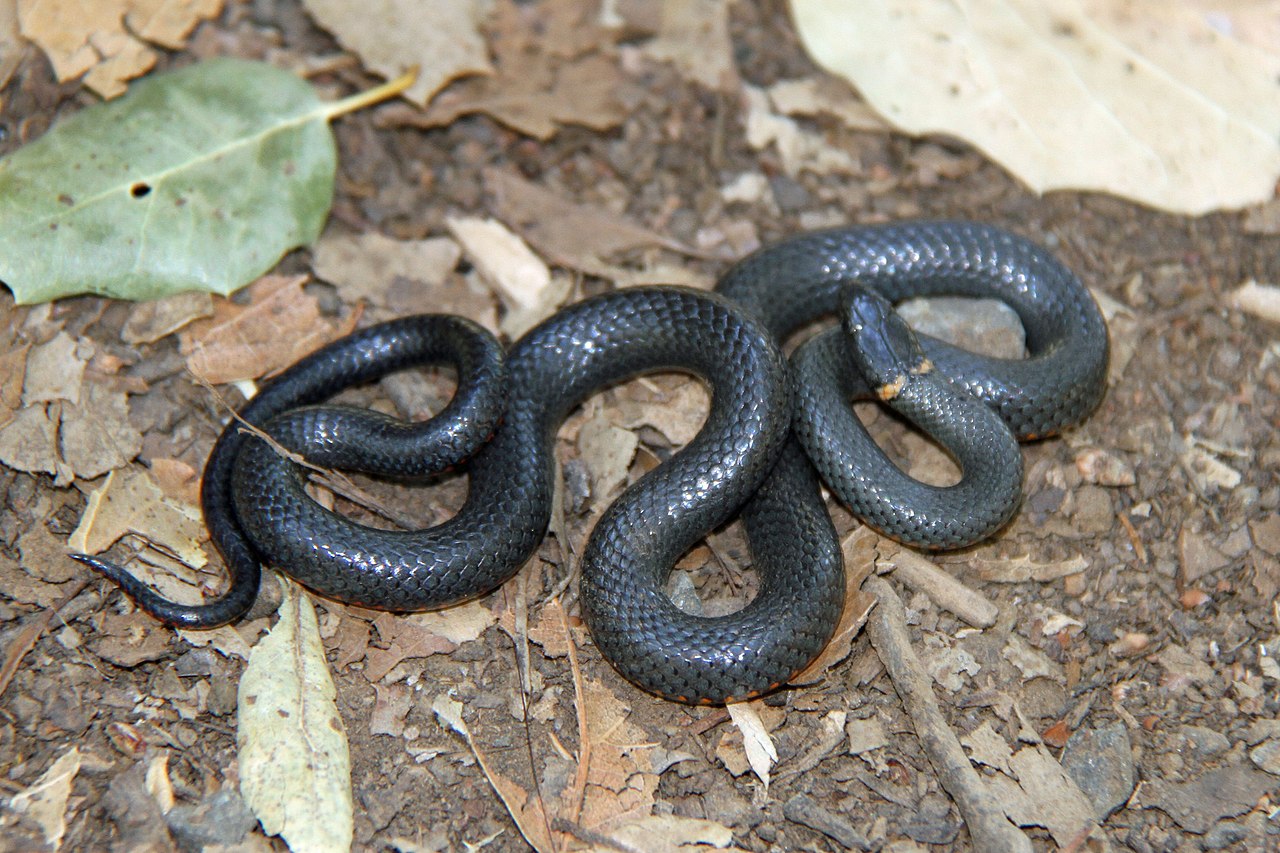
Scientific name: Diadophis punctatus
Common name: Ring-necked snake, Ringneck snake
Venomous: No
Ring-necked snakes are found all over Florida. This is a small species of snake that grows to a length of just a few inches.
Snakes of this genus have a bright yellow, red, or orange underbelly and a matching colored ring around the neck, which might be missing in some cases. Their body is normally black.
Snakes of this genus are nocturnal and predatory.
They come out at night seeking food such as lizards and salamander. They sometimes eat frogs and insects as well.
Snakes of this genus are found in all habitats. However, females prefer to lay up to 7 eggs in humid habitats.
8. Ribbon Snake
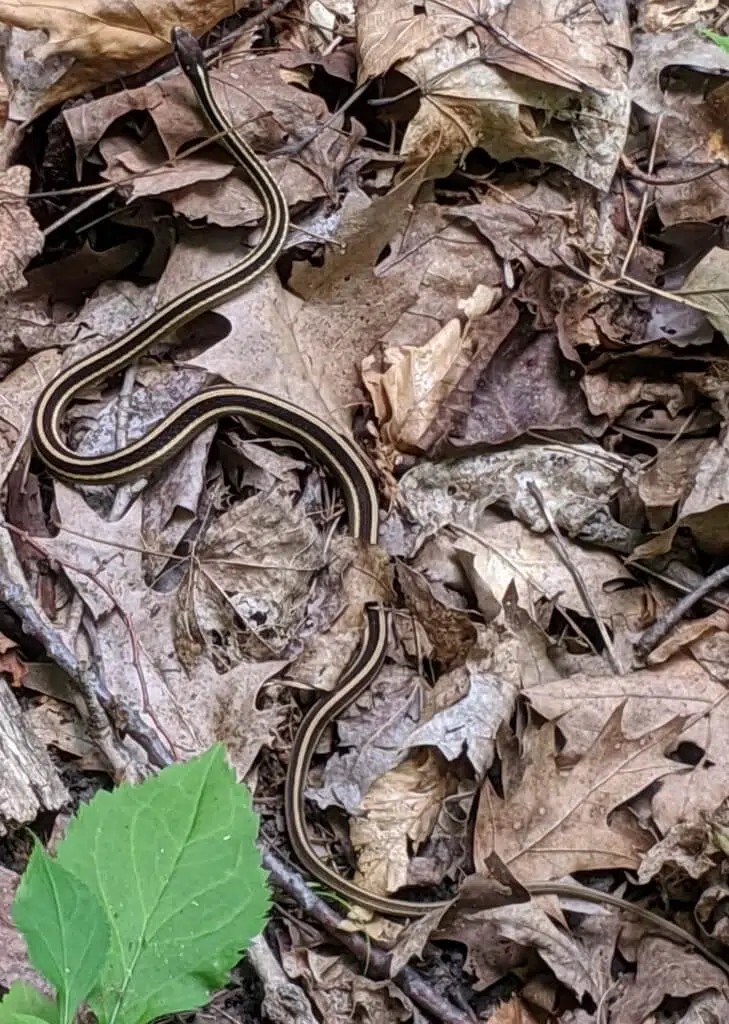
Scientific name: Thamnophis saurita
Common name: Ribbon snake
Venomous: No
Ribbon snakes are among the most common species in Florida. They live next to water sources and they feed on fish and amphibians.
These snakes are known for having yellow longitudinal stripes and a yellow underbelly.
Snakes of this genus grow up to 28 inches. They can be considerably smaller in some regions of the state.
Ribbon snakes can be as short as 14 inches as adults.
Juveniles of the species resemble adults, but they’re generally darker.
A juvenile Ribbon snake that measures 9-10 inches gas a dark green color and dark yellow to green longitudinal stripes instead of the bright yellow longitudinal stripes of adult snakes.
9. Eastern Diamond-backed Rattlesnake

Scientific name: Crotalus adamanteus
Common name: Eastern diamond-backed rattlesnake, Eastern diamondback, Diamond rattlesnake, Diamond-back rattlesnake, Common rattlesnake, Diamond-back, Diamond(-patch) rattler, Eastern diamond-back (rattlesnake).
Venomous: Yes
The Eastern Diamond-backed Rattlesnake is present in all Florida counties.
This is a venomous species dangerous to pets and people. Its venomous bite requires medical attention.
Snakes of this genus thrive in Florida’s flatwood forests, particularly in pine forests.
The ideal Florida habitat allows the female snake to give birth to a large number of snakes at the end of the summer.
Female Eastern Diamond-backed Rattlesnakes can give birth to as many as 29 young.
This species might be venomous but it doesn’t strike without provocation. It prefers to remain calm and coil its body when discovered. It only bites when roughly handled.
10. Brown Watersnake
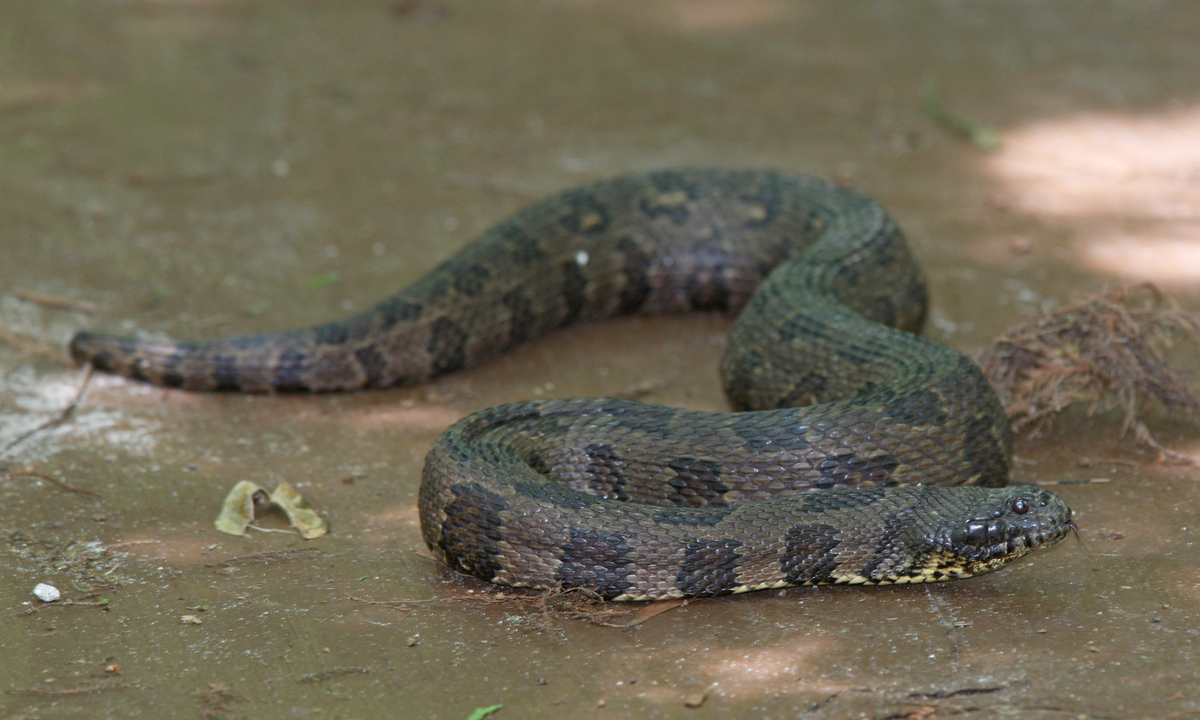
Scientific name: Nerodia taxispilota
Common name: Brown watersnake, Water-pilot, Aspic, false moccasin, Great water snake, Pied water snake, Southern water snake, Water rattle
Venomous: No
Brown coloration with dark brown blotches, a short thick body, and a semi-aquatic nature make Brown snakes one of the most confusing species of Cottonmouths in Florida.
Brown watersnakes aren’t venomous. However, these snakes are aggressive and can inflict a painful bite when surprised or threatened.
Snakes of this genus are always found next to the water. They prefer flowing freshwater to saltwater.
Brown watersnakes are found next to ponds and rivers. They aren’t known for a preference for traveling long distances from these water sources.
This species prefers riparian zones or areas with plenty of overhanging vegetation used for hiding as a launching point for fish.
11. Brahminy Blindsnake

Scientific name: Indotyphlops braminus
Common name: Brahminy blindsnake, Flowerpot snake, Common blind snake, Island blind snake, Teliya snake, Hawaiian blind snake
Venomous: No
The Brahminy Blindsanke is a small black species common in Florida during the summer months.
Without good vision, this snake can still make its way indoors.
Snakes of this family make their way through loose soil and ground-level leaves.
Since they measure a maximum of 6 inches they are often confused with worms.
However, these snakes eat the eggs of ants and termites, and they can be seen as a beneficial species.
12. Eastern Coachwhip

Scientific name: Masticophis flagellum flagellum
Common name: Eastern coachwhip
Venomous: No
Coachwhips are some of the longest snakes in Florida. The species grows to a size of 8 feet.
Snakes of this genus are partially brown and partially black. They have a black head and a body that’s brighter and brown towards the tail.
These snakes are often seen in various habitats raising their heads above vegetation and looking for food.
They eat lizards, birds, and amphibians.
Snakes of the genus also mate in high numbers. Female Eastern Coachwhips lay up to 24 eggs at once.
13. Pine Woods Littersnake

Scientific name: Rhadinaea flavilata
Common name: Pine Woods Littersnake, Yellow-lipped snake, Brown-headed snake
Venomous: No
Pine Woods Littersnakes are brown to red-brown. Snakes of this species are known for being secretive, as they hide under leaf litter.
As their name implies, the snakes are common in pine woodlands, but these woodlands need to be close to water.
Snakes of this genus are found in scattered populations across Florida.
14. Common Garter Snake

Scientific name: Thamnophis sirtalis
Common name: Common garter snake
Venomous: No
The Common Garter snake is a populous genus in Florida.
There’s no official consensus on how this species truly look as they are so many sub-species to the gnus.
Most people know it as a green or gray snake with longitudinal stripes.
This species is one of the complex species of Florida due to very good communication.
Males and females emit pheromones to attract a mate.
The male Common Garter snake is known to also emit female pheromones to attract males, mainly to share their body heat after long periods of hibernation.
This fouling technique helps male Common Garter snakes exit the hibernation state sooner.
15. Rough Greensnake

Scientific name: Opheodrys aestivus
Common name: Rough Greensnake, Grass snake, Green grass snake
Venomous: No
The Rough Greensnake is one of the most slender species in Florida, Georgia, and other neighboring states.
This snake measures up to 31 inches but it’s one of the most slender species in the state.
Its green dorsal and yellow underbelly make it one of the species easy to identify.
Rough Greensnakes can be seen in dense vegetation. Snakes of this genus are very good climbers and they’re often found on trees where they eat insects.
Most time of the day is spent looking for food by this slender species.
Apart from insects such as flies and moths, these snakes also eat spiders.
16. Eastern Coralsnake

Scientific name: Micrurus fulvius
Common name: Eastern coral snake, American cobra, Candy-stick snake, Common coral snake, Coral adder, Elaps harlequin snake, Florida coral snake, Harlequin coral snake, North American coral snake, Red bead snake, Thunder-and-lightning snake, Serpiente-coralillo arlequín
Venomous: Yes
The Eastern Coralsnake is one of the venomous species found in Florida.
It lives in scattered populations across many areas of the state, including on sandy soil.
This species is identified by its black, red, and yellow-colored rings along its body.
Most of these snakes aren’t easily seen as Eastern Coralsnakes live underground.
They come out to feed on lizards and other small prey.
All bites associated with this snake should be treated seriously with immediate medical attention.
The highest risk of running into one of these snakes is in Florida, particularly in pine woodland.
Snakes of this genus have also been reported in suburban areas.
17. Scarletsnake

Scientific name: Cemophora coccinea
Common name: Scarletsnake
Venomous: No
Scarletsnakes look almost exactly like the Eastern Coralsnake.
It’s believed this mimicry behavior of the snake is developed to its advantage as other predators see it as a venomous species as well.
Scarletsnakes aren’t venomous. They have a red, black, and yellow or gray body and a pointed snout.
Snakes of this species only come out to eat at night which means sightings are rare.
Some of the highest chances of seeing them are in the summertime when they might come at dusk until late August.
18. Scarlet Kingsnake

Scientific name: Lampropeltis elapsoides
Common name: Scarlet kingsnake, Scarlet milk snake
Venomous: No
Scarlet Kingsnakes have red, black, and yellow coloring. These slender snakes aren’t venomous even if they resemble Coral snakes.
Scarlet Kingsnakes are found all over Florida but might be difficult to see as they hide under rocks, debris, and logs.
Snakes of this genus are generally aggressive, even if they aren’t venomous.
Scarlet Kingsnakes bite repeatedly when handled.
This snake might also release a foul smell before or when handled. This is a defensive behavior used to keep predators away.
The mating season is long in this species. Females can lay eggs anywhere between July and November.
19. Gray Ratsnake

Scientific name: Pantherophis spiloides
Common name: Gray ratsnake, Central ratsnake, Chicken snake, Midland ratsnake, Pilot black snake
Venomous: No
Gray Ratsnakes are known as versatile species. They live in almost any habitat from woodlands to open lands.
The snake is a good climber often seen on trees where it tries to catch birds or to eat eggs out of their nests.
Gray Ratsnakes have a name inspired by their underground nesting in rat burrows.
Snakes of this genus are also known for laying eggs underground.
Gray Ratsnakes don’t tolerate cold temperatures which always makes them seek out new rodent burrows to hide in.
20. Mudsnake

Scientific name: Farancia abacura
Common name: Mudsnake
Venomous: No
Mudsnakes are some of the most aquatic snakes in Florida. This species is known for living in wetlands and temporary wetlands.
Mudsnakes rarely leave water which makes them a very rare sight.
They have a black dorsal and a yellow and red underbelly.
Snakes of this genus remain hidden in water vegetation even when there are boats or people nearby.
They can be seen crossing roads at night. They move from one wetland to another, specifically when it rains.
Snakes of this genus poke prey with their tails.
21. Dekay’s Brownsnake

Scientific name: Storeria dekayi
Common name: De Kay’s brownsnake, De Kay’s snake, Brown snake
Venomous: No
Snakes of this species grow to a maximum adult size between 6 and 11 inches. They are mostly brown.
While they can inhabit various terrains, they are mostly seen in cypress swamps and other swamps around the state.
Some of these snakes are found by mistake whenever picking up logs.
These brown snakes are known for only eating soft prey, mainly due to their small size.
They are known for eating slugs and worms.
Snakes of this species might be seen after a rainy day when worms and slugs come out on roads.
22. Florida Brownsnake
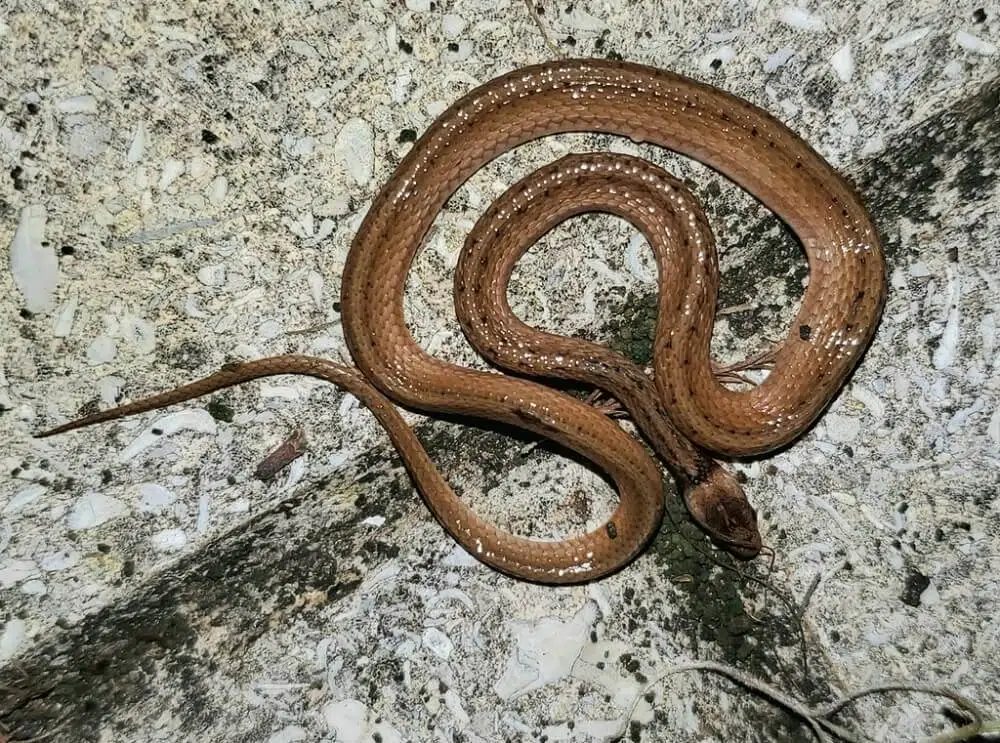
Scientific name: Storeria victa
Common name: Florida brownsnake
Venomous: No
This short brown snake is native to Florida. It grows to a maximum size of 13 inches.
As a distant relative to the Brownsanke, the Florida Brownsnake also like moist habitats, swamps, and areas around swamps.
This species is afraid of people and it tries to flee in case of direct contact.
Florida Brownsnakes hide under leaves and vegetation when seeing people.
Known for a black stripe that runs from the head to the tip of the tail dorsally, this species is easy to identify as it’s mostly brown.
Its young snakes are also of a similar color. Adult Florida Brownsnakes can start mating after they reach the age of 3.
23. Eastern Indigo Snake

Scientific name: Drymarchon couperi
Common name: Eastern indigo snake, Indigo, Blue indigo snake, Black snake, Blue gopher snake, Blue bull snake
Venomous: No
The Eastern Indigo snakes are one of the largest in the state and the country. It grows to a size of just over 80 inches.
Eastern Indigo snakes are mostly compared with the similar-looking Texas Indigo snakes.
Both have an almost completely black body.
This snake species isn’t venomous. It doesn’t like to be threatened and it starts making hissing sounds when cornered.
You can only see these diurnal snakes during the day in the summer.
They migrate to dry sheltered soils in the winter.
24. Eastern Copperhead

Scientific name: Agkistrodon contortrix
Common name: Eastern copperhead, Copperhead
Venomous: Yes
The Eastern Copperhead species is one of the most venomous in Florida.
Snakes of this genus are known for their potent venom which might not kill people but which still cause serious bite symptoms.
These gray and brown snakes are known to live both at low and high altitudes.
They are out for food both during the day and during the night when they might find various birds and amphibians to feed on.
Low terrain woodlands offer the highest chances of seeing this species.
The mating season might also be one of the ideal moments to see members of the species together.
The end of the spring marks the debut of their mating season.
25. Eastern Hog-nosed Snake

Scientific name: Heterodon platirhinos
Common name: Eastern hog-nosed snake, Spreading adder, Spread’em outer, Hog-nosed snake, Adder, Bastard rattlesnake, Black adder, Black blowing viper, Black hog-nosed snake, Black viper snake, Blauser, Blower, Blowing adder, Blowing snake.
Venomous: No
Eastern Hog-nosed snakes get their name from their upward-facing snout.
These snakes are found in areas with salamanders, birds, and other small animals.
They are known to have different morphs which include a black and yellow morph, a black and gray morph, and even a plain black color.
Eastern Hog-nosed snakes aren’t venomous or dangerous as they prefer to avoid confrontation with people.
They might even fake their deaths for people to leave them alone.
Eastern Hog-nosed snakes play dead until the perceived danger is gone. These snakes can mate in high numbers with up to 25 eggs being laid at a time.
26. Rainbow Snake
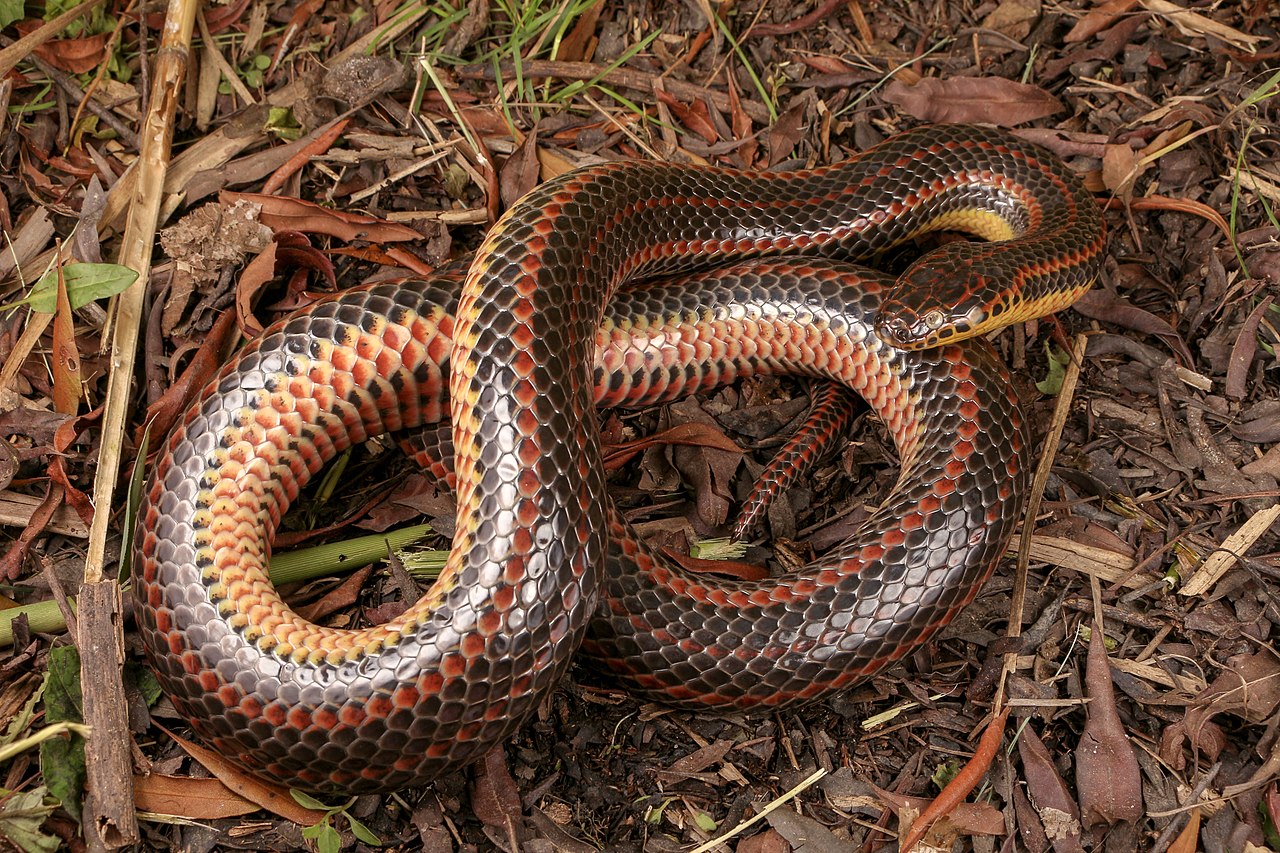
Scientific name: Farancia erytrogramma
Common name: Rainbow snake, Eel moccasin, Horn snake, Red-lined snake, Red-lined horned snake, Red-sided snake, Sand hog, Sand snake, Striped wampum
Venomous: No
Rainbow snakes are one of the numerous non-venomous coastal specie in Florida.
These aquatic snakes live in water and are identified by their dark dorsal and rainbow-looking underbelly.
Since they spend a lot of time in the water these snakes might not appear as common as research suggests.
Highly active during the night, this species is believed not to be aggressive.
Rainbow snakes can be handled with care as they don’t bite.
Females of the species are among the most prolific at breeding as they can lay tens of eggs at a time after mating.
27. Red-bellied Snake

Scientific name: Storeria occipitomaculata
Common name: Red-bellied snake, Redbelly snake
Venomous: No
Red-bellied snakes are among the smallest in Florida. They grow to a maximum length of 11 inches even if they can be as small as 4 inches.
They are identified by contrasting dorsal and underbelly colors.
Various morphs of the species exist. They include a common dark gray and red underbelly morph.
Most of the day is spent hiding. Snakes of this genus only come out to eat.
Slugs are their favorite meal.
Females give birth to live young after mating.
This is typically the end of the summer.
Up to 9 live young snakes are born at the end of the summer.
28. Florida Green Watersnake
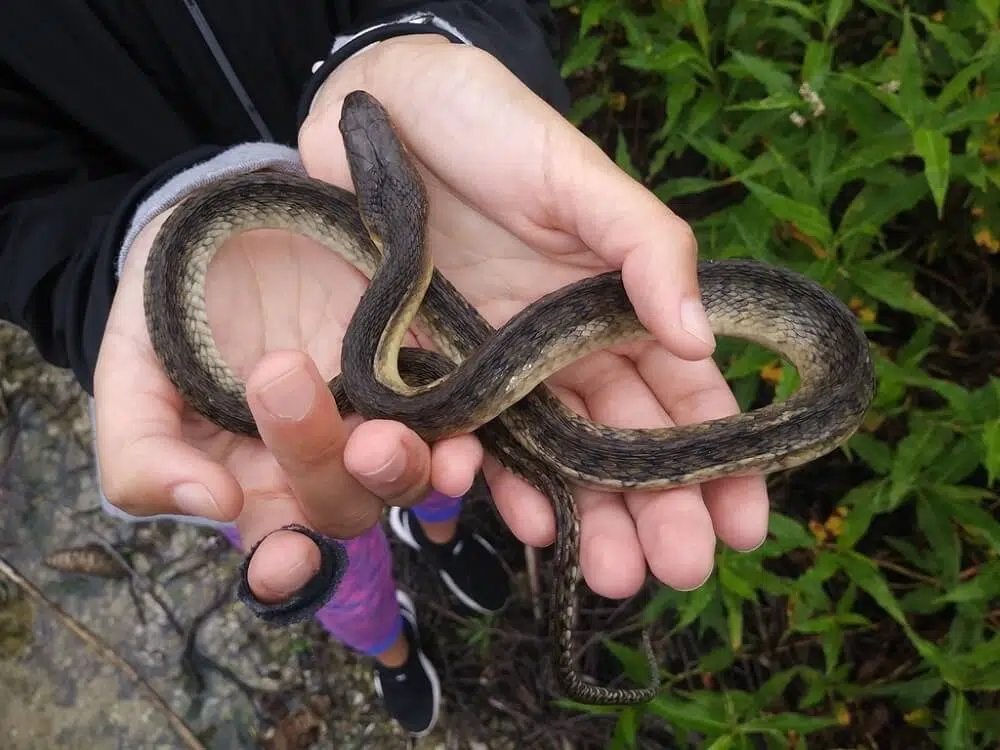
Scientific name: Nerodia floridana
Common name: Florida green watersnake, Eastern green watersnake
Venomous: No
The Florida Green Watersnake is one of the largest aquatic species in the state.
These snakes grow to a size of up to 55 inches. They are uniformly brown or brown and black.
Common in swamps and marshes, they are mostly known for eating fish.
The large aquatic snake is also known for mating in high numbers. Up to 100 live young are born of a female after mating.
This species isn’t yet endangered.
Still, diminishing waterland and temporary wetlands make this species one of the potential snakes to start a decline in population across the state.
29. Eastern Kingsnake

Scientific name: Lampropeltis getula
Common name: Eastern kingsnake, common kingsnake, chain kingsnake, kingsnake, Carolina kingsnake, chain snake, bastard horn snake, black kingsnake, black moccasin.
Venomous: No
Eastern Kingsnakes are some of the most resilient species in Florida.
This snake comes with a mostly black body with yellow specs. Some morphs of the Eastern Kingsnakes are uniformly-black.
Constriction is the main hunting method of this predatory species.
Eastern Kingsnakes are most active during the day in the summer when they might be seen constricting and eating birds.
This snake also eats venomous snakes such as Copperheads.
They can eat almost any type of Florida snake as they’re immune to venomous snake bites.
30. Saltmarsh Snake

Scientific name: Nerodia clarkii
Common name: Saltmarsh snake
Venomous: No
The Saltmarsh snake is a small species. It grows from a minimum of 15 inches to a maximum of 30 inches as an adult snake.
Saltmarsh snakes are found in coastal regions, as their name suggests. It doesn’t live in freshwater as it prefers to eat crabs and shrimp.
Unlike many people believe, this species doesn’t drink dehydrating saltwater. It only drinks fresh rainwater.
This is why it carefully attacks seafood.
Excessive industrialization is the largest enemy in Florida. Coastal construction work limits and even eliminates the natural habitat of the species.
31. Timber Rattlesnake

Scientific name: Crotalus horridus
Common name: Timber rattlesnake, canebrake rattlesnake, banded rattlesnake
Venomous: Yes
These venomous snake species are identified by a red line that runs in the middle of its brown-blotched dorsal.
The species is not present in most of Florida as it prefers higher ground. However, scarce populations of this venomous snake exist in the state.
Timber Rattlesnakes take a long time to mature. Females take up to 5 years to mature and to become sexually active.
As young snakes, they feed on rodents and similarly-sized mammals.
These snakes grow to a size of up to 60 inches. As they mature, they can begin eating larger animals such as squirrels and rabbits.
32. Black Swampsnake
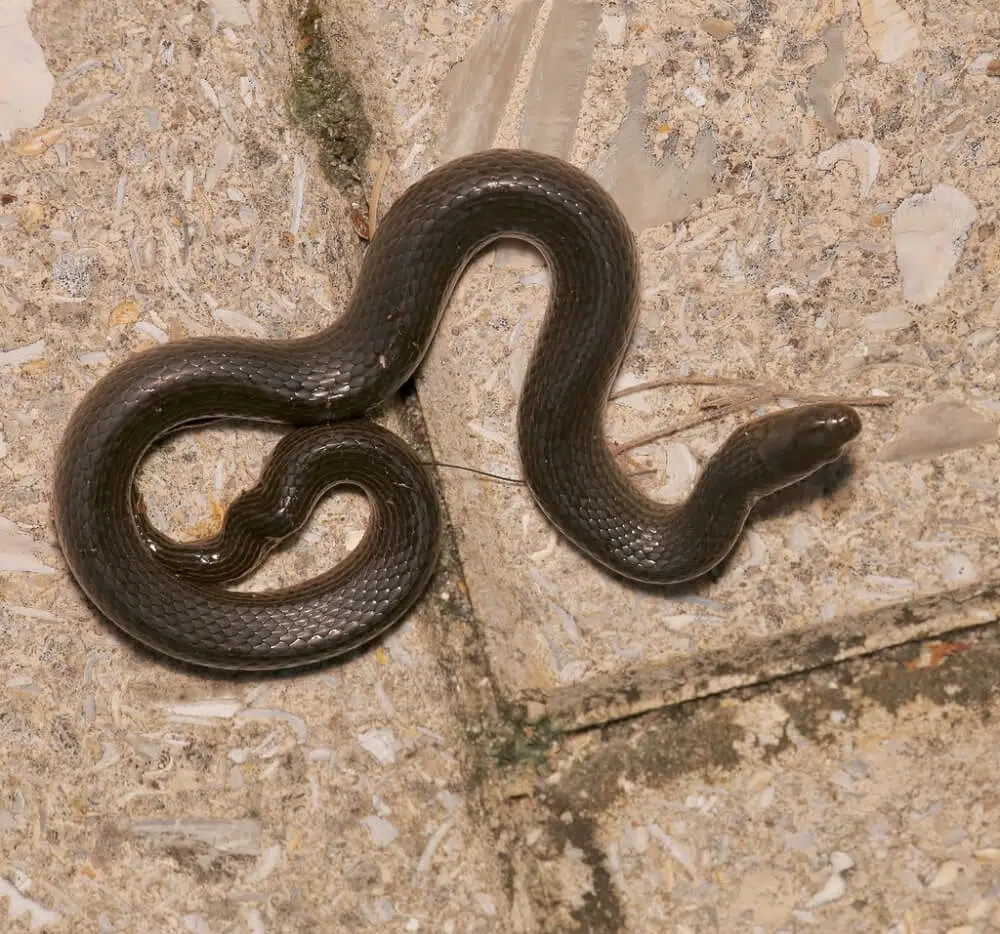
Scientific name: Liodytes pygaea
Common name: Black swampsnake, mud snake, red-bellied mud snake, swamp snake
Venomous: No
These small snakes are identified by their black dorsal and red underbelly.
They grow to an average of 8 inches being one of the smaller Florida snakes species.
As their name implies, Black Swampsnakes are highly common in swamps, particularly around cypress swamps.
These snakes don’t bite and they don’t have any venom to use against predators.
Black Swampsnakes flee when they see people.
Nocturnal creatures, these slender short snakes only come out to feed at night.
They mostly eat earthworms but they can also go for small fish or small salamander.
33. Burmese Python

Scientific name: Python bivittatus
Common name: Burmese python
Venomous: No
The Burmese Python is one of the species accidentally introduced to Florida.
This python grows to a very long size of up to 23 feet and it might have reached the number of an invasive species in Florida.
Most sightings have been reported in Florida Everglades where constant efforts are put in place to capture all Burmese Pythons.
These pythons have escaped private capture to eliminate almost all snakes and small animals in their habitat.
Rabbits are among the species that have been most affected by the accidental presence of these pythons in the state.
34. Florida Kingsnake
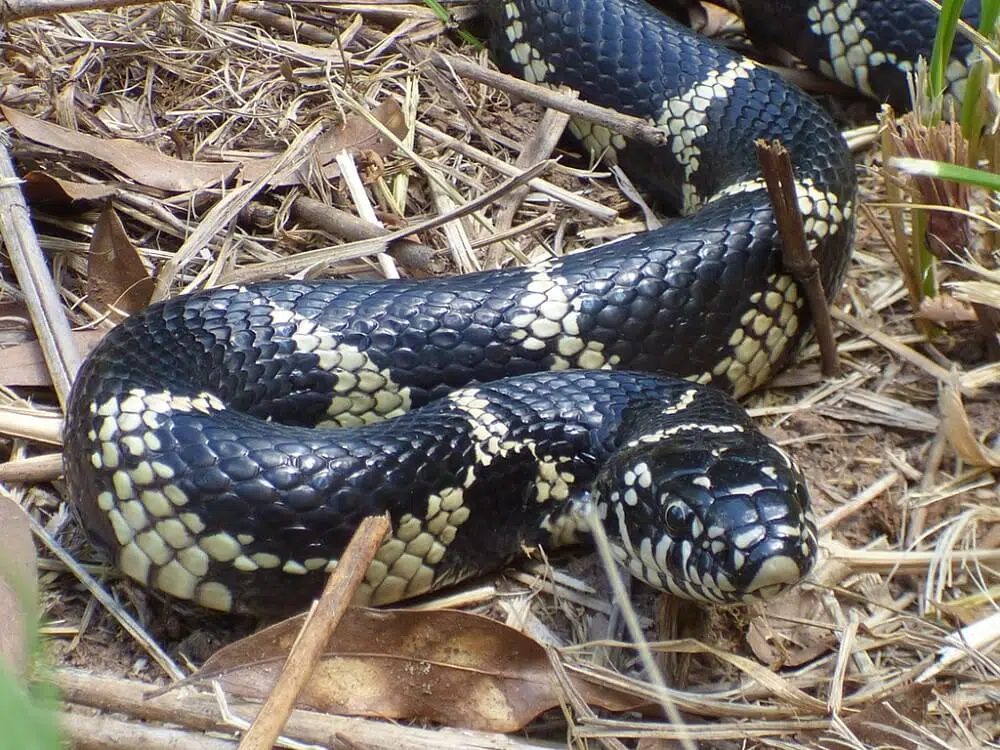
Scientific name: Lampropeltis floridana
Common name: Florida kingsnake
Venomous: No
The Florida Kingsnake isn’t venomous. This species has a brown body with tan crossbands.
Snakes of this genus inhabit forests and pine woodlands.
They aren’t known as aggressive as they prefer to flee whenever seeing people.
While these snakes can bite, they aren’t dangerous to people.
They prefer to release a foul smell first. Snakes of this species are also known for poking people and other animals to test out reactions.
Florida Kingsnakes feed on small animals such as birds and eggs.
As constrictors, they occasionally eat larger species that are swallowed once suffocated.
35. African Rock Python

Scientific name: Python sebae
Common name: African rock python
Venomous: No
The African Rock Python is one of the accidental species in Florida Everglades.
It has a similar status as the Burmese Python in the state, but with fewer sightings.
This is a type of very large python that grows to 20 feet, just a few feet less than the Burmese Python.
Its extreme size allows it to eat large animals such as goats.
Snakes of this genus are believed to have escaped private collections in the state and contributed to the almost complete extinction of rabbits in Florida Everglades.
The species isn’t venomous but it’s expected to mate fast. Up to 100 eggs are laid by a female after mating.
36. Pine Snake
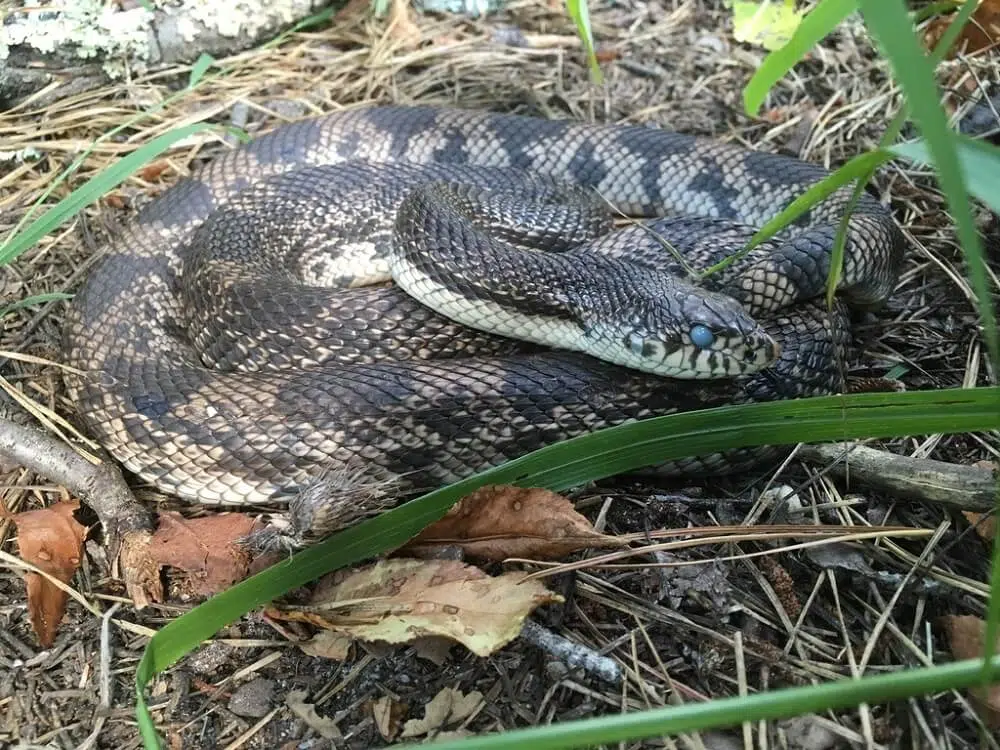
Scientific name: Pituophis melanoleucus
Common name: Pine snake
Venomous: No
Pine snakes are found in almost all regions of Florida. This species is only found in scarce locations outside the state.
Pine snakes are black, yellow, and gray. These snakes grow to 66 inches and they’ve known burrowers.
They spend most time underground or hiding under leaf litter.
These snakes are most active in the summer from May to October.
One of its distinctive traits is the ability to lay eggs in communal nests. Females deposit their eggs in the same spot.
This is one of the reasons why these snakes are mostly seen in sandy soils as they need to dig deep to lay eggs.
37. Florida Crowned Snake
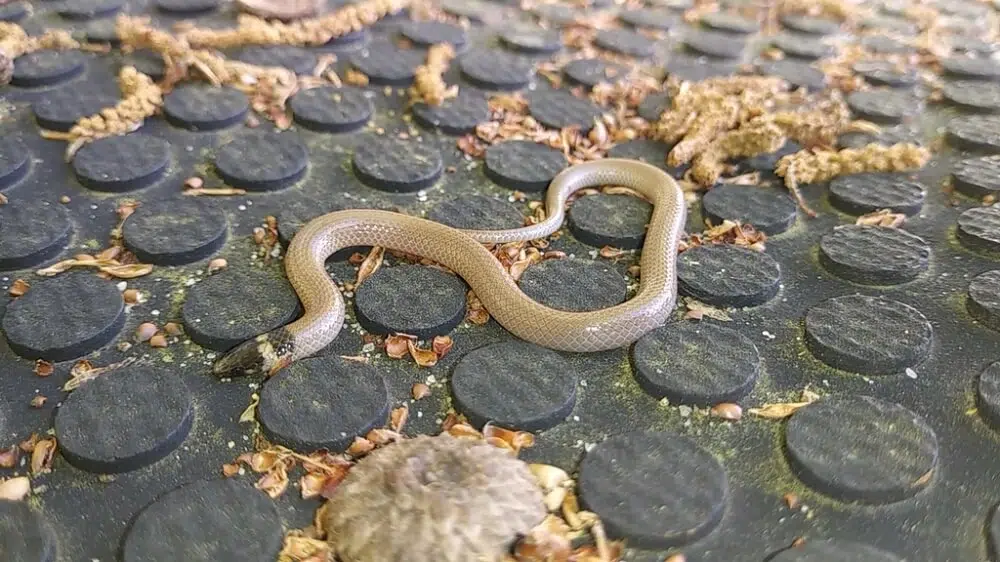
Scientific name: Tantilla relicta
Common name: Florida crowned snake
Venomous: No
The Florida Crowned snake is a tan-red snake. A slender short body is characteristic of the species as it never grows longer than just a few inches.
These snakes live in the ground and are found in most areas of the state.
You can find them on sandy terrains as well as on grassland.
Non-venomous and not dangerous to people, the species is nocturnal.
This is one of the reasons it’s not seen too often.
These snakes are mostly interested in eating beetles and beetle larvae.
Snakes of this genus resort to releasing a foul smell if surprised by humans.
38. Smooth Earthsnake

Scientific name: Virginia valeriae
Common name: Smooth earth snake
Venomous: No
These snakes are known for their brown or gray uniform coloring.
They grow to a short size of 7 to 10 inches and are found underground.
Found in coastal regions of Florida, the Smooth Earthsnake is fossorial.
It prefers to hide underground using its pointy snout to move around. It also hides under leaf litter and logs.
Females of the species give birth to live young after mating. They can give birth to as many as 14 live young snakes at the end of the summer.
39. Midland Watersnake

Scientific name: Nerodia sipedon pleuralis
Common name: Midland watersnake
Venomous: No
This non-venomous species is known for its crossbands and blotches.
It grows to 34 inches and it can be light brown, dark brown, light green, or dark green.
Snakes of this genus are aquatic and very good swimmers. They feed on several freshwater fish and other invertebrates around freshwater in the state.
Midlands Watersnakes use their powerful jaws to capture slippery fish.
These snakes prefer to swim away when seeing people.
Females of the genus also give birth to live young similarly to Smooth Earthsnakes.
Up to 30 young snakes are born per single female in the summer.
40. Striped Swampsnake

Scientific name: Liodytes alleni
Common name: Striped crayfish snake, Allen’s snake, Swamp snake
Venomous: No
This species inhabits canals, swamps, and other wetlands. They have a brown or a brown-yellow color and they grow to a maximum size of 30 inches.
Stripped Swampsnakes aren’t venomous or aggressive.
They swim away when under threat.
Some snakes of this genus are also known to play dead when under threat. Others are known for swinging their heads when cornered as a means to appear larger.
This species is mostly nocturnal and chances of seeing one are slim. They come out at night looking for prey such as crayfish.
41. Mole Kingsnake
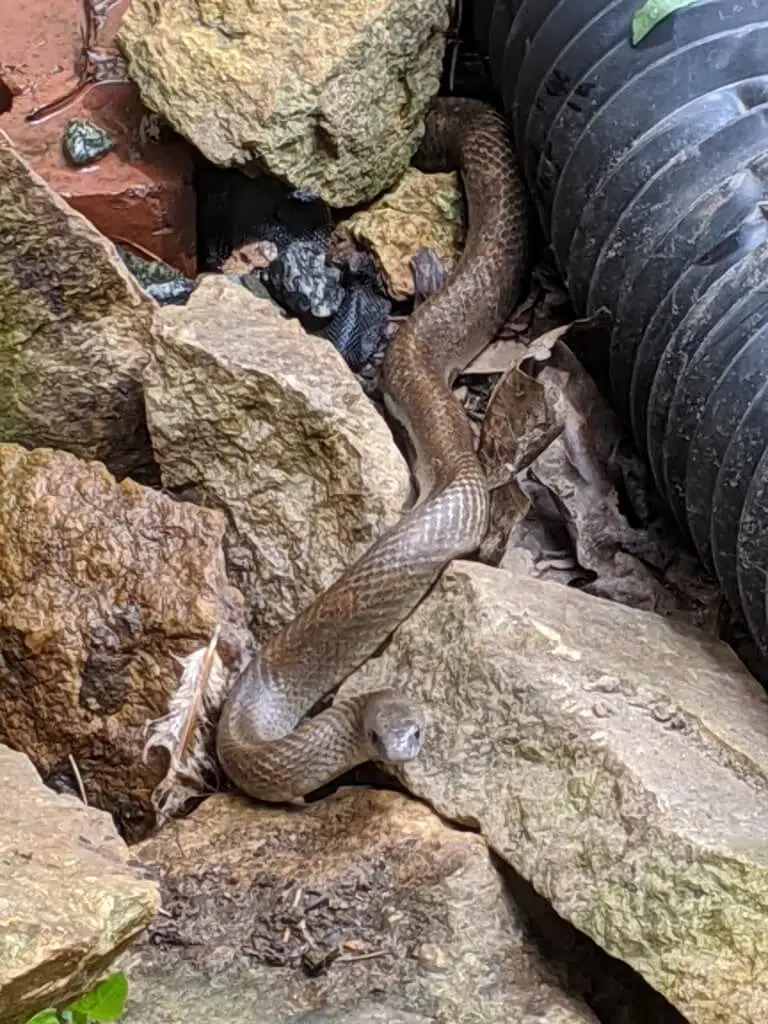
Scientific name: Lampropeltis rhombomaculata
Common name: Mole kingsnake, Brown kingsnake
Venomous: No
Mole Kingsnakes are one of the largest fossorial snakes in Florida. They grow to a maximum size between 30 and 40 inches.
This species spends most of its life underground. It has a light brown, red, and dark brown blotched coloring.
Snakes of this genus are accidentally stumbled upon when lifting large rocks or logs during the day,
They are a nocturnal species that prefers to eat lizards and birds. However, they can’t climb.
42. Mississippi Green Watersnake

Scientific name: Nerodia cyclopion
Common name: Mississippi Green Watersnake, Green water snake
Venomous: No
These snakes are common in slow-moving Florida waters. This includes swamps and canals.
Snakes of this family are known to avoid confrontation with people and try to make a quick escape by swimming away when surprised by humans.
If cornered, the Mississippi Green Watersnake bites at least once. Even its young are known to defend themselves when cornered.
Snakes of this genus aren’t constrictors. They use their jaws to trap prey and prevent a quick escape.
They prefer to eat freshwater fish and other amphibians that live next to slow-moving waters.
43. Glossy Swampsnake

Scientific name: Liodytes rigida
Common name: Glossy swampsnake, Glossy crayfish snake, Glossy water snake, Striped water snake, Crayfish snake
Venomous: No
The Glossy Swampsnake is one of the most secretive species in Florida. This aquatic snake isn’t easy to find as it prefers the extreme South of peninsular Florida.
They are known to be brown with a yellow underbelly.
Snakes of this genus grow to a length of 24 inches.
Aggression isn’t specific to this species, even when handled as it prefers to make hissing sounds.
These snakes mostly feed on crayfish. They have strong teeth that allow them to eat hard-shell crayfish.
44. Rough Earthsnake

Scientific name: Haldea striatula
Common name: Rough Earthsnake, brown ground snake, brown snake, ground snake, little brown snake, little striped snake, small brown viper, small-eyed brown snake, southern ground snake, striated viper, worm snake
Venomous: No
Rough Earthsnakes live underground. They are a brown, gray, or gray-red species.
Rough Earthsnakes are found only in certain parts of peninsular Florida.
They live secretive lives away from sight hiding beneath logs, leaf litter, driftwood, and other debris.
Snakes of this genus feed on soft prey such as earthworms.
45. Red-tailed boa
Scientific name: Boa constrictor
Common name: Red-tailed boa, Common boa
Venomous: No
This is a non-venomous snake introduced to North America from South America a few decades ago.
It grows to a maximum size of 116 inches. They have a blotched tan, gray, or green body.
These snakes are some of the most common constrictors in the world and can be seen in hardwood hammocks around the state.
They prefer to hide in dense vegetation and ambush various prey such as rats and opossums. They can eat any Florida mammal as well.
Boa snakes tend to bite people when cornered. They might try constricting humans while holding down the bite.
46. Apalachicola Kingsnake

Scientific name: Lampropeltis getula meansi
Common name: Apalachicola kingsnake, Apalachicola Lowlands kingsnake
Venomous: No
This snake species grows up to 48 inches and it has alternating specks coloring.
They live in hardwood hammocks and pinelands.
Snakes of this genus prefer not to bite people. They prefer to ambush birds and feed on their eggs.
As Boas, these snakes are also constrictors. They lay up to 30 eggs after mating.
47. Plain-bellied Watersnake

Scientific name: Nerodia erythrogaster
Common name: Plain-bellied watersnake, Plainbelly watersnake
Venomous: No
Plained-bellied Watersnakes have a typical gray-green coloring with a pale yellow underbelly but they come in many morphs.
These are among the watersnakes that spend a lot of time on land in Florida.
Plain-bellied watersnakes are common in the water in the summer. This is when they find plenty of fish and crayfish to feed on.
They travel long distances by ground in the winter. They need to prepare for hibernation away from water.
Its mixed habitat also makes it one of the most targeted snakes in Florida.
Both aquatic and terrestrial predators eat this type of snake, especially as a juvenile.
48. Short-tailed Kingsnake

Scientific name: Lampropeltis extenuata
Common name: Short-tailed Kingsnake
Venomous: No
This patterned snake reaches a maximum length of 20 inches.
It lives in pine and oak woodlands preferring dry soil or mildly-moist soil.
Snakes of this genus are known for false strikes when it comes to humans. They mimic a bite with their closed mouths without having an intention to bite.
49. Southeastern Crown Snake
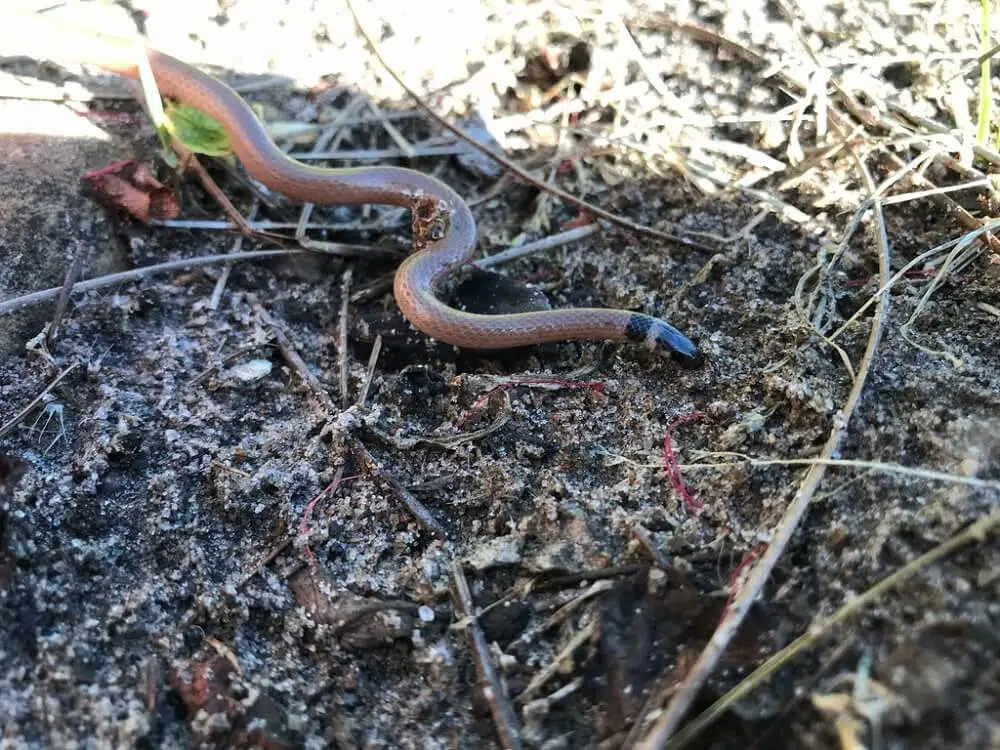
Scientific name: Tantilla coronata
Common name: Southeastern crown snake
Venomous: No
The Southwestern Crowned snake is common in coastal regions of Florida.
It has a tan to the brown body color and a black head or a head that’s tan-brown with black marks on top.
Snakes of this genus grow up to 10 inches.
This is one of the secretive species in the state as it lives an underground life. It eats insects and spiders but it doesn’t pose a threat to humans or animals.
Snakes of this genus are among those with very low reproductive rates by state standards.
They can lay a single egg following their mating season.
50. Southern Hog-nosed Snake
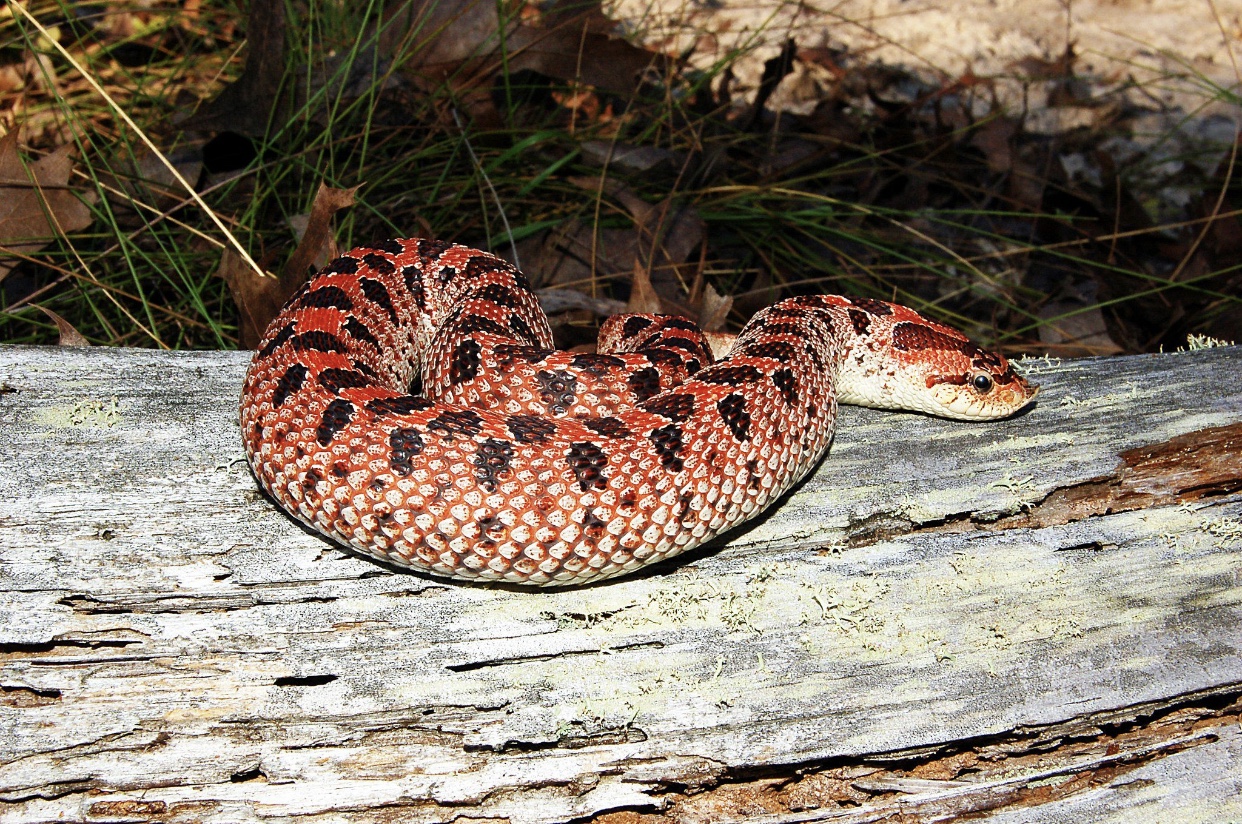
Scientific name: Heterodon simus
Common name: Southern hog-nosed snake
Venomous: No
The Southern Hog-nosed snake grows to a maximum size of 24 inches.
They live in sandy Florida habitats and are often seen in these areas early in the morning.
Southern Hog-nosed snakes only eat toads with occasional exceptions.
They are immune to toxic toads and can eat them due to their long rear fangs.
51. Queensnake

Scientific name: Regina septemvittata
Common name: Queensnake, banded water snake, brown queen snake, diamond-back water snake, leather snake, moon snake, North American seven-banded snake, olive water snake.
Venomous: No
Quuensnakes are a type of crayfish snake common in Florida.
They have a gray-green body with a yellow underbelly.
Quuensnakes live semi-aquatic lifestyles mostly together with other snakes that eat crayfish.
However, Queensnakes cannot eat all types of crayfish such as Glossy Swampsnakes. They can only eat soft crayfish.
These snakes are very common in streams and Florida rivers.
52. Rim Rock Crowned Snake
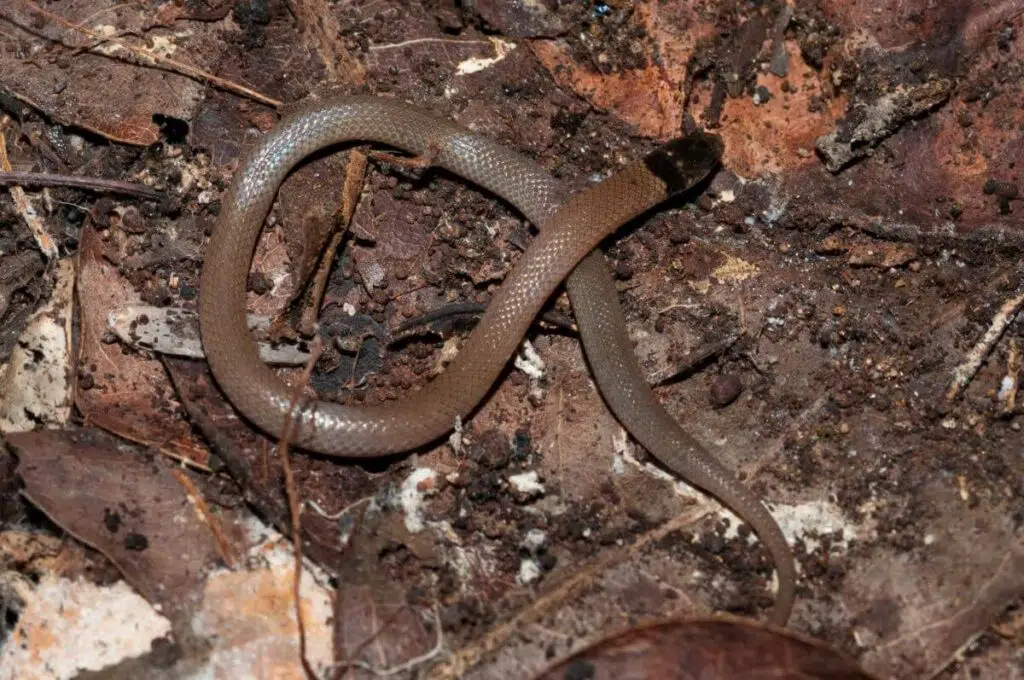
Scientific name: Tantilla oolitica
Common name: Rim rock crowned snake
Venomous: No
Worms, centipedes, and spiders in South Florida are the main diet of the Rim Rock Crowned snake.
This small slender species is known for its red-brown body and its black head.
The species grows to a maximum size of 9 inches.
Found in hardwood hammocks, this species also inhabits the Florida Keys.
The Rim Rock Crowned Snake is one of the endangered species in Southern Florida.
A diminishing habitat is one of the main reasons this snake isn’t as common as it used to be.
Pine rocklands and hardwood hammocks are now at a historical minimum in Southern Florida which means the natural habitat of the species is under threat.